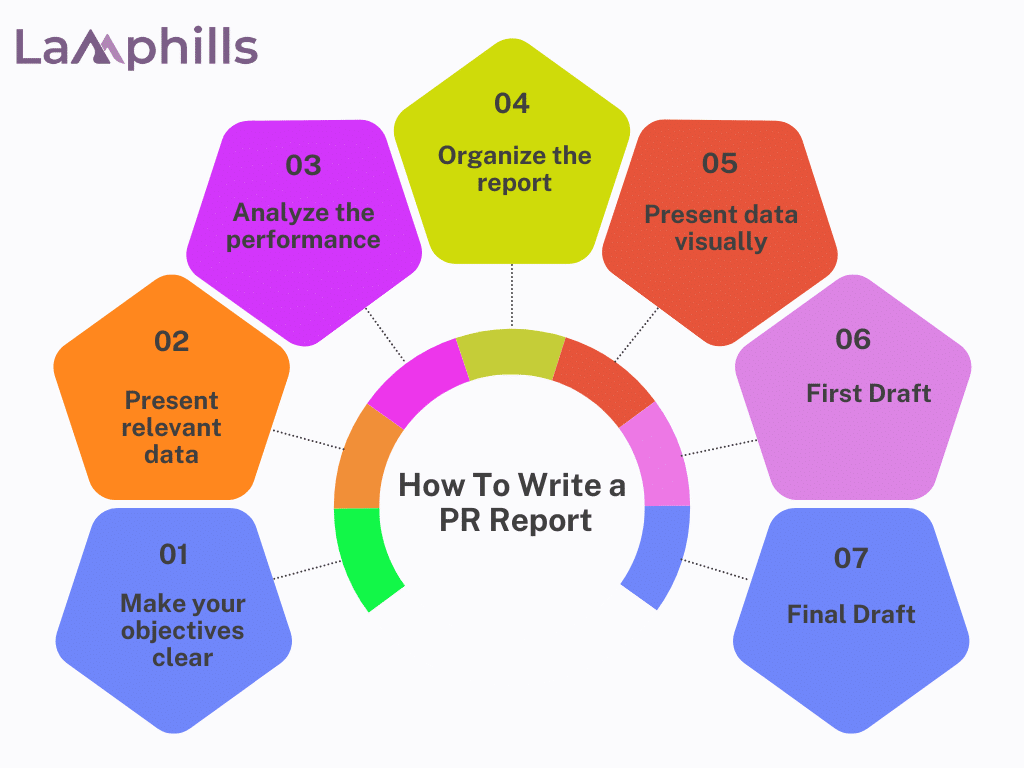Writing a PR report is easy. Yes, I said it. You must have faced difficulties in the past when the time came to present PR reports. But all the stress comes from your anxiety and an innate tiring feeling that we all get when we hear the word “report.”
No one likes writing reports. I had a field trip in school in my third year and almost everyone could attest that it was an informational trip. Despite that, when we were asked to write a comprehensive report of the trip, nearly everyone folded.
I didn’t, though. I got paid to write more than 10 different reports on the same field trip. It was a task, but… writing reports has always been one of my talents. Writing a PR report is just as easy as any other report. By the end of this article, you’ll have all you need to write a PR report like a pro. Though it’s comprehensive, it’s going to be easy.
What is a PR Report?
In our world today, information is constantly flowing and public perception can make or break your brand. You must learn how to create an effective PR report.
A public relations report (PR report), is an important tool for checking the impact of your PR efforts and communicating results to stakeholders and respective clients. It provides a detailed overview of your PR activities, media coverage, and the all-round effectiveness of your strategies.
A PR report outlines the performance of your public relations activities over a specific period. It showcases the results of your PR campaigns, including media coverage, social media impact, and overall brand sentiment.
PR reports are essential for demonstrating the value of PR efforts to clients, executives, or internal teams. A good report is what will earn you the checks that place you in the big leagues.
With them, you can analyze what’s working, what’s not, and how you can improve your strategies moving forward. Let’s talk about how to create a good PR report and provide you with free templates to help your process.
Key Takeaways
- Clear objectives and SMART goals are crucial for a focused and measurable PR campaign.
- Collect comprehensive and relevant data using tools like Google Analytics and social media insights.
- Analyze your PR campaign’s performance through trends, SWOT analysis, and industry comparisons.
- Organize your PR report logically with sections such as Executive Summary, Objectives, and Key Metrics.
- Use visual aids like charts and graphs to make complex information more digestible and engaging.
How To Write a PR Report

- Make your objectives clear
- Present relevant data
- Analyze the performance
- Organize the report
- Present data visually
- First Draft
- Final Draft
You can take several steps to start a good PR campaign and draft a good PR report for your client. These steps would act as guidelines before and during the campaign and keep you in check when drafting the report so you don’t go testing your descriptive skills and boring your clients.
These steps include;
#1. Make Your Objectives Clear
Objectives are important in PR campaigns. They effectively summarise your report and determine if Clients should sit for the rest of your pitch. A PR campaign with clear objectives or goals should;
- Identify Goals
- Be SMART
- Align with Business Goals
Your objectives should outline what you aim to achieve with your PR activities, guiding the metrics you track and report on. What are the primary goals of your campaign? Ensure to identify these first. Are you pushing to increase brand awareness, improve public perception, or drive engagement?
Once you’ve identified these, Use the SMART guidelines to measure your goals. They must be Specific, Measurable, Achievable, Relevant, and Time-bound. For example, “Increase media coverage by 20% over the next quarter.”
Can you see how that is SMART? SMART guidelines will keep you in check and present you in a more composed manner. In short, “SMART Goals will maintain your Steeze”. Don’t forget to align them with the business goals in mind. This is to demonstrate the value of PR activities in achieving organizational success.
#2. Present Relevant Data
Collecting comprehensive data is crucial for an insightful PR campaign. This data will form the backbone of your analysis and conclusions. Without good data, all your information would seem far-fetched and boneless.
Gather data from relevant social media platforms like Twitter Analytics, Facebook Insights, and Instagram Insights to measure engagement, reach, and sentiment. Tools like Meltwater, Cision, or Google Alerts will help track media mentions and coverage.
Collect data from internal sources, such as website analytics (Google Analytics), email marketing stats, and customer feedback.
#3. Analyze the Performance
It’s time to see how well your PR campaign is performing. This step involves identifying trends, successes, and areas for improvement. No campaign is perfect, there are always loopholes to fill.
When analyzing trends, look for patterns in media coverage, social media engagement, and other metrics over time. You can also gauge the performance of your campaign against industry standards to measure your success.
A SWOT analysis is also important (Strengths, Weaknesses, Opportunities, Threats). This threat provides a comprehensive view of your PR efforts. Now, it’s time to do your PR report.
#4. Organize the Report
A good PR report should be logically and coherently structured. You must present your findings so that your audience (clients) can easily understand them.
Firstly, remember that a PR report is not for you, it’s for your clients. Once you get lost in your writing and arrangement skills, you might lose sight of the main purpose of the report. When you keep the client in mind, you will sway towards a simplistic, self-explanatory report.
Provide a brief summary of the success of the campaign. Present key findings and recommendations. This section would give a snapshot of the report for those clients with short attention spans (who may not read the entire document).
Divide your report into sections. A clumsily written PR report annoys you, your client, and me too. Include sections for each aspect of your PR activities, such as media coverage, social media performance, and campaign analysis. Present the data and insights in a clear, organized way.
Immediately, offer practical recommendations based on your findings. This section should suggest steps to improve future PR strategies. It shows you’ve done your homework.
#5. Present Data Visually
Look at this;
“The quarterly sales figures show a steady increase from 5,432 units in January, 6,789 units in February, and 7,345 units in March, followed by a decline to 6,112 units in April and a slight recovery to 6,789 units in May, before peaking at 8,123 units in June.”
Don’t you feel sleepy reading that? There are better ways to present such information. Visualizing data through charts, graphs, infographics, and other visual tools helps to make complex information more digestible and engaging for your audience.
Tools like Tableau, Canva, and Microsoft Excel can help create professional and easy-to-understand visualizations.
#6. First Draft
Now that you know all these, it’s time for the first draft. Your first draft should;
- Be clear and concise
- Should have a narrative flow
- Insight-focused
Use clear, straightforward language. Avoid jargon and overly complex sentences. Also, ensure the report flows logically from one section to the next. Don’t let one paragraph stand naked. Let there be a link from the former to the present paragraph.
Headings and subheadings will help you guide the reader. Lastly, highlight key insights and their implications for your PR strategy. Explain why the data matters and how it can inform future actions.
#7. Final Draft
No first draft is good enough. That’s what I’ve learned after years of writing several reports. You are never so perfect that your work doesn’t need revision. Before finalizing your report, review it for accuracy and completeness. Make necessary revisions to ensure it meets the needs of your audience.
Check for spelling, grammar, and punctuation errors. Ensure the report is professionally presented. You should also seek feedback from colleagues or stakeholders to ensure the report is clear and understandable.
Once you’ve gotten your feedback, make final revisions based on it. Your report should be polished and ready for presentation.
When you follow these steps, you can create a detailed and impactful PR report that effectively communicates the success of your PR activities and provides actionable insights for future strategies LIKE A PRO!
Let’s talk about structure. I know you understand what to do. But it also helps when you understand the structure of how a good PR report should look.
How To Structure a PR Report

A well-structured PR report ensures that your findings are clearly communicated and easy to understand. Here’s a breakdown of the typical sections included in a comprehensive PR report:
#1. Title Page
Your title page should include the report title, date, and your organization’s name. Declare the report’s objective clearly (e.g., “Q2 2024 PR Report”).
Your organization’s name is foremost and important, include your company’s or client’s name for identification.
#2. Executive Summary
A brief overview of the report’s key findings and recommendations is key. Highlight the most important results from your PR activities. You should also provide high-level suggestions for future PR strategies. This is why it is a summary, it should cover most sections.
A quick snapshot for stakeholders who may not read the entire report will help.hs
#3. Objectives
Specific, Measurable, Achievable, Relevant, and Time-bound.
#4. Methodology
Explain how data was collected and analyzed. When you present your whole process clearly and honestly, it boosts trust in your report.
List the tools and platforms used to gather data, like media monitoring tools, and social media analytics.
#5. Key Metrics
Remember, I told you not every piece of information needs to be presented in your report. Present important metrics such as media impressions, social media engagement, and sentiment analysis. Media impressions talk about the number of times your content has been viewed in the media.
Social media engagement describes metrics such as likes, shares, comments, and overall engagement rate. Sentient Analysis presents the breakdown of positive, negative, and neutral mentions.
#6. Media Coverage
Present a detailed analysis of media mentions, including both quantitative and qualitative insights. The Quantitative data would touch on the number of media mentions, reach, and impressions. The qualitative insights would analyze the tone, message alignment, and overall quality of media coverage. You can also talk about major publications or channels that feature your content.
#7. Social Media Impact
“Reach, Engagement, and Sentiment.”
Analyze your social media performance, Breakdown performance metrics across different social media platforms. Talk about how audiences interacted with your content.
#8. Campaign Analysis
This is the final evaluation of the PR campaign. Start by restating the goals of the specific campaign. Present a detailed analysis of the campaign’s performance against its objectives. Look for areas of improvement.
#9. Conclusion and Recommendations
This is where you recap the main takeaways from your PR report. At the conclusion, you can take the time to put in the minds of your clients what you want them to take away. Provide clear, strategic suggestions to improve future PR efforts.
Outline the immediate actions to be taken based on the report’s insights.
If you follow this structure, you can create a PR report that effectively communicates the impact of your PR efforts and provides valuable insights for future strategies, LIKE A PRO!
What is a PR Writing Sample?
A PR writing sample could be a press release, a media pitch, a blog post, or any other type of content used in public relations.
It is a piece of written work that showcases your ability to write effective PR content. PR writing samples demonstrate your skills in writing clear, engaging, and persuasive content that aligns with the strategic goals of your PR efforts.
Who Should Receive a PR Report?
PR reports are directed toward senior management, clients, or internal teams. They are the ones to whom you owe any explanation (okay, that was too aggressive), They need to understand the impact of PR activities.
Actually, depending on the organization, PR might report to different departments, such as marketing, and communications, or directly to the executive team. The key is to ensure that the report reaches those who make strategic decisions based on the insights provided.
Types of PR Reports

- Monthly PR Report Template
- Campaign PR Report Template
- Social Media PR Report Template
- Media Coverage Report Template
- Executive Summary PR Report Template
What is PR?
Public Relations (PR) involves managing the spread of information between an individual or an organization and the public. PR professionals work to maintain and enhance the image and reputation of their clients or organizations through various communication strategies and media relations.
Is PR a form of journalism?
Public relations and journalism are similar in that they seek to communicate with the public; however, the goals and tactics are very different. The goal of journalism is to give the public objective information so that they can make their own decisions.
What is the first step in the PR process?
The first step in the process is analyzing the problem or opportunity. This involves research, either formal or informal, to gather information that best describes what is going on. Research used to understand the situation and help formulate strategies is called formative research.
Conclusion
Creating a comprehensive PR report is an invaluable practice for any PR professional like yourself. It not only showcases the success of your efforts but also provides insights for further improvement. If you follow the steps outlined in this guide and utilize the provided templates, you can streamline your reporting process and deliver impactful PR reports that resonate with your audience.
With these insights and templates, you’re now equipped to create detailed and compelling PR reports that speak greatly of your hard work and strategic impact.
Happy reporting!
Related Articles
- How to Protect Your Brand Online & Offline (Expert Tips)
- Media Pitch vs. Press Release: How I Differentiate Them.
- How to Write a Good Restaurant Press Release (My Templates)






